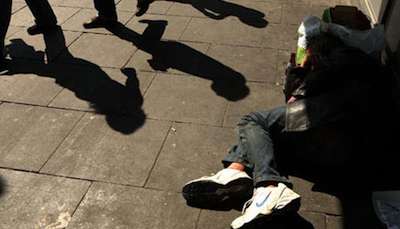 By Arnold Ahlert
By Arnold Ahlert
For the first time in the 20 years the Heritage Foundation and the Wall Street Journalhave complied their annual “Index of Economic Freedom,” the United States no longer occupies a spot among the top ten nations.
After seven straight years of decline, America comes in at number 12, just behind Estonia. Sadly, America’s decline is occurring even as the level of economic freedom throughout the 186 countries analyzed by the Index has reached record highs.
The Index analyzes four different categories in order to determine a country’s ranking. They are the rule of law, limited government, regulatory efficiency and open markets. The subheadings under those general headings reveal much of the reason the United States continues to decline.
Under the “Rule Of Law” heading, America has improved with regard to freedom from corruption, but property rights have declined. Heritage explains that the increasing use of government regulatory agencies to manage economic activity has led to increased perceptions of cronyism and corruption. And while they contend the judiciary functions independently and predictably, there has been an “uneven” protection of property rights that fosters charges of favoritism.
Under the “Limited Government” heading, Heritage reveals that spending has increased even as fiscal freedom has declined. The contributing factors are the increase in the personal income tax rate to 39.6 percent, and a corporate tax rate of 35 percent (the world’s highest). Far more ominous, America’s overall tax burden is 25.1 percent of gross domestic income, government expenditures total 40 percent of our Gross Domestic Product, and total public debt is “over 100 percent of the size of the economy.”
In terms of “Regulatory Efficiency,” labor and monetary freedoms have increased, while business freedom has declined. Heritage reveals that incorporating a business takes an average of five days, but 130 regulations imposed since 2009 have increased the overall burden of compliance by $60 billion. And while labor markets remain “flexible,” there has been an increase in “price distortions” caused by Quantitative Easing, as well as subsidies for agriculture, welfare and healthcare programs.
Under the category of “Open Markets,” trade freedom has increased, while the ratings for financial and investment freedom remain unchanged. Heritage attributes those conditions to relatively new “non tariff barriers” such as restrictions on the importation of tomatoes from Mexico, the capping of foreign investment in media and airlines, and the partial imposition of the Dodd—Frank financial regulation bill. They also note that a “backlog” of ongoing rulemaking” has led to “prolonged business uncertainty” that inhibits economic growth.
“It’s not hard to see why the U.S. is losing ground,” writes Terry Miller, one of the study’s directors, in the Wall Street Journal. “Even marginal tax rates exceeding 43% cannot finance runaway government spending, which has caused the national debt to skyrocket. The Obama administration continues to shackle entire sectors of the economy with regulation, including health care, finance and energy. The intervention impedes both personal freedom and national prosperity.”
Miller further notes the irony behind the reality that the level of freedom has increased for 114 nations over the last year, including 43 that have now reached their highest economic freedom ranking since the Index was started, even as the United States languishes. Those nations are embracing the same policies “that made the U.S. economy the most powerful in the world,” he explains. Furthermore, he considers it “inexcusable” that we continue to pursue policies antithetical to the nation’s growth, even as we wield our influence “to encourage other countries to chart the same disastrous course.” He concludes that America needs “a drastic change in direction.”
Barring a miracle, that’s not about to happen. The Obama administration remains mired in the populist politics of wealth redistribution and income inequality.
Yet beneath that populist facade, reality bites. Despite Obama’s lamentations about “fairness,” the gap in employment rates between the nations highest- and lowest-income families is the widest it’s been since the Great Depression. Those on the bottom end of the scale, as in families earning less than $20,000, are enduring an unemployment rate of 21 percent. Those at the top end, with household earnings of more than $150,000 a year have an unemployment rate of 3.2 percent. All of this has occurred during the five years Obama has made at least 21 promises to pivot towards economic growth.
Unfortunately, the unemployment rate only paints half the picture. As a disturbing studyby Emmanuel Saez, a professor at the University of California, Berkeley reveals, there has indeed been wealth redistribution during the Obama years—upward. From 2009 through 2010, the the top 1 percent of U.S. earners garnered 93 percent of all income growth in the nation. By comparison, from 2002-2007 the top 1 percent of earners garnered only 65 percent. Four years after the study, Wall Street remains close to record highs, even as 92 million Americans have stopped looking for work.
Obamanomics ever-expanding government
In 2010, Timothy P. Carney, author of “Obamanomics,” explained why the ever-expanding government favored by the American left is inimical to the interests of the nation as a whole. “Every time government gets bigger somebody is getting rich,” he noted. He further explained that the increasing influence of lobbyists is only possible as government worms its way into more and more aspects of American life, and increasing regulation favors big business because they are better able to absorb the costs, even as those costs crush their smaller, would-be competitors.
In other words, the more government grows, the more economic freedom diminishes. Dr. Kim R. Holmes, a founding editor of the Index affirms this reality. Commemorating the 20-year anniversary of the undertaking, he reveals his key finding: “More than any other political or policy approach, economic freedom generates more opportunities and greater well-being for more people.” And Holmes defines economic freedom as a combination of free markets, limited government and rules-based capitalism.
As Miller counters, the least economically free nations also have similar defining characteristics. “All are governed by crony-populist regimes pushing policies that have made property rights less secure, spending unsustainable and inflation evermore threatening,” he writes.
Obama administration. Crony-populism
Examples of these dubious qualities are not particularly hard to find within the Obama administration. Crony-populism, for example, might describe giving $535 million ingovernment loans to a fiscally unstable company like Solyndra, in pursuit of a populist “green” agenda favored by radical environmentalists. Private property rights are being threatened right now, as the Obama administration pursues a massive expansion of the EPA’s Clean Water Act authority. That expansion would give the EPA control over any body of water that has any effect on downstream “navigable waters,” and the Obama administration’s unprecedented control over private property. With regard to unsustainable spending, four years of trillion dollar-plus deficits, and a $17 trillion national debt are self explanatory.
As for inflation, the QE policies pursued by the Federal Reserve will eventually debase the currency to the point where massive inflation may be unavoidable. That same QE policy has enriched Wall Street investors, while its counterpart, the Fed’s Zero Interest Rate Policy (ZIRP), has killed any possibility of Main Street Americans getting decent return on their savings.
All of these interventionist factors have taken their toll. In 2010, for the first time since the Index began keeping track of economic freedom, our nation fell below the cutoff number of 80 on a scale of 1-100. A score of 80 or above separates the “free” economic nations from the “mostly free.” Our score at that time was 78.0, and we have declined steadily ever since.
Now it is 75.5. What it will be by the end of the Obama administration’s second term is impossible to say. But as long as this administration continues to pursue policies aimedat “fundamentally transforming the United States of America,” there is little doubt which direction the nation will be headed for the next three years.
Credit to Canada Free Press
All of these interventionist factors have taken their toll. In 2010, for the first time since the Index began keeping track of economic freedom, our nation fell below the cutoff number of 80 on a scale of 1-100. A score of 80 or above separates the “free” economic nations from the “mostly free.” Our score at that time was 78.0, and we have declined steadily ever since.
Now it is 75.5. What it will be by the end of the Obama administration’s second term is impossible to say. But as long as this administration continues to pursue policies aimedat “fundamentally transforming the United States of America,” there is little doubt which direction the nation will be headed for the next three years.
Credit to Canada Free Press
No comments:
Post a Comment